Unveiling Utah’s Geological Tapestry: A Journey Through Time and Terrain
Related Articles: Unveiling Utah’s Geological Tapestry: A Journey Through Time and Terrain
Introduction
In this auspicious occasion, we are delighted to delve into the intriguing topic related to Unveiling Utah’s Geological Tapestry: A Journey Through Time and Terrain. Let’s weave interesting information and offer fresh perspectives to the readers.
Table of Content
Unveiling Utah’s Geological Tapestry: A Journey Through Time and Terrain

Utah, a state renowned for its dramatic landscapes, stands as a testament to the intricate interplay of geological forces over eons. The Utah Geological Survey (UGS), a vital resource for understanding the state’s natural history and potential, has meticulously compiled a geological map that serves as a key to deciphering this intricate tapestry. This map, a visual representation of the state’s subsurface, reveals the story of rock formations, mineral deposits, and the dynamic processes that have shaped Utah’s diverse terrain.
A Symphony of Time and Stone:
The Utah Geological Map is not merely a static image; it is a dynamic chronicle of geological events spanning billions of years. The map’s colors and patterns represent different rock units, each with its unique story to tell. From the ancient Precambrian basement rocks, remnants of Earth’s primordial crust, to the younger Cenozoic sediments, deposited during the rise of the Rocky Mountains, the map captures the evolution of the landmass.
Unveiling the Past:
The map is a powerful tool for understanding the history of Utah’s geology. It reveals the locations of ancient seas, vast deserts, and volcanic eruptions. The intricate patterns of folding, faulting, and erosion tell tales of tectonic collisions, volcanic activity, and the relentless forces of wind and water. By studying these geological markers, scientists can reconstruct the past environments, climates, and events that shaped the state.
A Guide to Resources:
Beyond its historical significance, the Utah Geological Map holds immense practical value. The map identifies areas rich in mineral resources, including coal, oil, natural gas, uranium, and precious metals. It also highlights areas prone to natural hazards like landslides, earthquakes, and floods, providing valuable insights for land management and infrastructure development.
Understanding the Present:
The geological map is essential for understanding the present-day landscape. It reveals the underlying geological structures that control the flow of groundwater, the stability of slopes, and the potential for geothermal energy. This knowledge is crucial for managing water resources, mitigating natural hazards, and developing sustainable energy solutions.
A Foundation for the Future:
The Utah Geological Map is a valuable resource for planning for the future. By understanding the geological processes that have shaped the state, we can make informed decisions about land use, resource management, and infrastructure development. The map helps us anticipate potential hazards, identify areas suitable for different uses, and ensure the long-term sustainability of Utah’s natural resources.
Frequently Asked Questions (FAQs):
Q: What information is included on the Utah Geological Map?
A: The Utah Geological Map presents a comprehensive overview of the state’s geology, including:
- Rock formations: The map displays different rock units, their age, and composition.
- Structural features: It shows major faults, folds, and other geological structures.
- Mineral resources: The map identifies areas with potential for mineral deposits.
- Geologic hazards: It highlights areas susceptible to landslides, earthquakes, and floods.
Q: How is the Utah Geological Map created?
A: The Utah Geological Survey (UGS) creates the map through a combination of field studies, laboratory analysis, and digital mapping techniques. Geologists collect data from outcrops, boreholes, and aerial surveys, then analyze the data to create a comprehensive geological model.
Q: How can I access the Utah Geological Map?
A: The Utah Geological Survey (UGS) provides online access to the map, along with accompanying data and information. The map can be accessed through the UGS website or through various online mapping platforms.
Q: What are the benefits of using the Utah Geological Map?
A: The Utah Geological Map offers numerous benefits, including:
- Understanding geological history: It provides insights into the evolution of Utah’s landscape.
- Identifying mineral resources: It helps locate potential deposits of valuable minerals.
- Managing natural hazards: It aids in identifying areas prone to landslides, earthquakes, and floods.
- Planning for the future: It provides essential data for land use, resource management, and infrastructure development.
Tips for Using the Utah Geological Map:
- Study the legend: Familiarize yourself with the map’s symbols, colors, and abbreviations.
- Explore different layers: The map may include multiple layers of information, such as rock units, faults, and mineral resources.
- Use online tools: Utilize interactive mapping platforms to zoom in on specific areas and explore the data in greater detail.
- Consult with experts: If you have specific questions or require more detailed information, contact the Utah Geological Survey (UGS) for assistance.
Conclusion:
The Utah Geological Map is a remarkable testament to the power of science and its ability to unravel the mysteries of the Earth. It serves as a vital resource for understanding the state’s geological history, identifying natural resources, managing hazards, and planning for the future. By utilizing this map, we can gain a deeper appreciation for Utah’s unique geological heritage and make informed decisions for the sustainable management of its natural resources.


![Unveiling Utah's Geode Wonders: 17 Captivating Sites to Explore [Video]](https://i.pinimg.com/736x/dc/87/a5/dc87a5a074a119d8a67ff7c727eac6c3.jpg)





Closure
Thus, we hope this article has provided valuable insights into Unveiling Utah’s Geological Tapestry: A Journey Through Time and Terrain. We hope you find this article informative and beneficial. See you in our next article!